CE Expiration Date:
CEU (Continuing Education Unit): Credit(s)
AGD Code:
Educational aims and objectives
This clinical article aims to discuss the features, differences, and use of carrier-based obturation techniques Thermafil and GuttaCore.
Expected outcomes
Endodontic Practice US subscribers can answer the CE questions by taking this quiz to earn 2 hours of CE from reading this article..
Correctly answering the questions will demonstrate the reader can:
- Realize some history of carrier-based obturation techniques.
- Identify some carrier features.
- Identify some gutta-percha external layer characteristics.
- Recognize some characteristics of verifiers.
- Read about sealing ability of these materials.
- Recognize some protocols of use and suggestions for obtaining better clinical results.
In this CE regarding carrier-based obturators, Drs. Giuseppe Cantatore, Katia Greco, and Lajos Palffi discuss the features, differences, and protocols of use with Thermafil compared to GuttaCore.
Drs. Giuseppe Cantatore, Katia Greco, and Lajos Palffi discuss the features, differences, and protocols of use with Thermafil compared to GuttaCore
The carrier-based obturation concept was initially described by Dr. W.B. Johnson in 1978. However, the first carrier-based obturator (Thermafil) with a metal carrier was only commercialized in 1991. First-generation Thermafil had a metal carrier, and the final obturation was characterized by a steel core in the middle of a layer of sealer and gutta percha. This design led to difficulties when post space or pretreatment was needed (Cantatore, Goracci, Maviglia, 1992; Cantatore, Goracci, Maviglia, 1993). As a result of these problems, later versions were redesigned as Thermafil® Plus (Dentsply Sirona) — an obturator with plastic carriers — was introduced (Figure 1).

In the last 20 years, carrier-based obturation techniques have become very popular with the introduction of many different types of obturators including ProTaper® Obturators, ProTaper® Next™ Obturators, WaveOne® Gold Obturators, GT Obturators (all Dentsply Sirona) and so on (Figure 2). These obturators differ from the original Thermafil due to the taper and diameter of the carrier that is optimized for the corresponding endodontic instruments. However, when the clinician uses a precise protocol, the use of these “dedicated” obturators is not mandatory since the original Thermafil Plus, with its high flow and good adaptation of its gutta percha, can be used after preparation with any file system.
The most recent major design change in carrier-based obturation (2012-2013) has led to cross-linked gutta-percha carriers from Dentsply Sirona (USA) and VDW (Germany) and the introduction of GuttaCore® and GUTTAFUSION respectively. GuttaCore and GUTTAFUSION® are the same product with a few differences in the design of the handle (Figure 3) and manufactured by two different distributors. (Editor’s note: Currently, GUTTAFUSION is not available in the U.S.)
In this two-part article, the authors will refer mainly to GuttaCore since it was first to the market and has been the object of a significantly higher number of studies than GUTTAFUSION. Since heated discussions continue to occur between supporters and detractors of the obturators with plastic and cross-linked gutta percha carriers, the authors will compare them according to the available literature and clinical experience.
In this article, the following topics will be discussed:
- Carrier features
- Gutta-percha external layer characteristics
- Verifiers
- Sealing ability
- Protocols of use and suggestions for obtaining better clinical results
The second part of this article will be dedicated to the drawbacks of the carrier-based obturation technique, the possible complications, the protocol for preparation of the dowel space, and retreatments in easy and difficult cases.
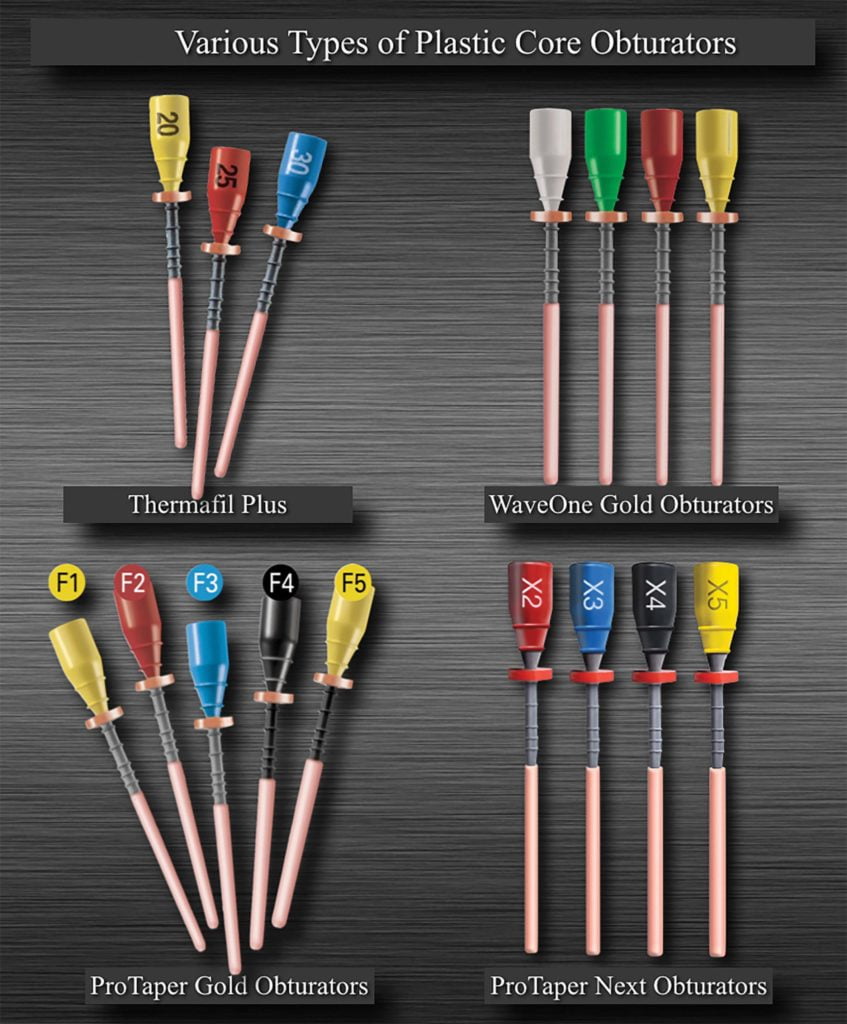
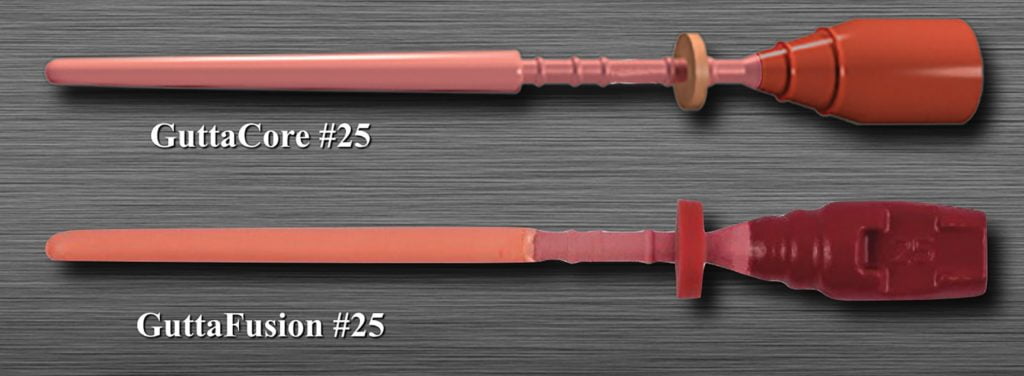

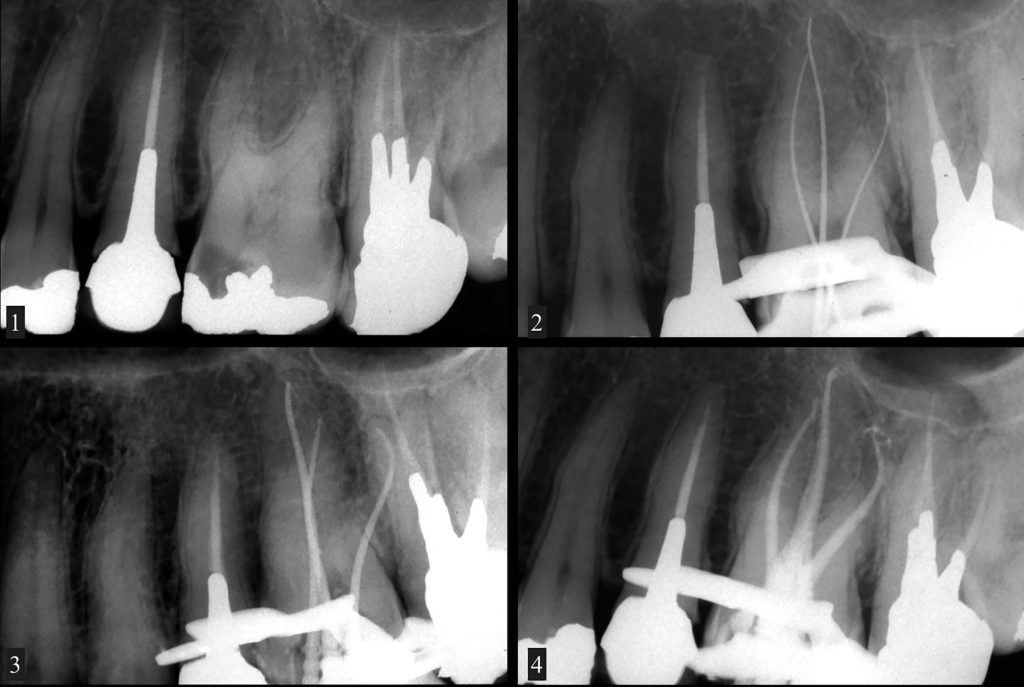
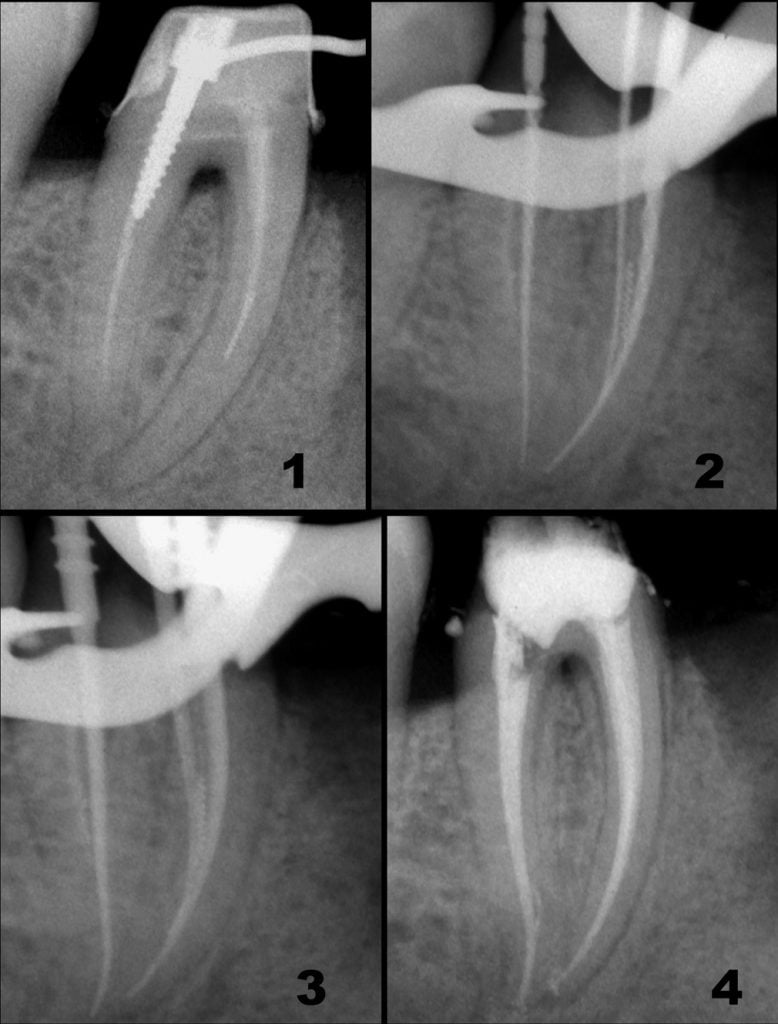
Figure 5: (left) (1) Endodontic treatment of UL6; (2) working-length determination. Radiopaque plastic carriers X-ray; (3) the correct plastic carrier should block 1 mm short of the working length; (4) postoperative X-ray. Gutta percha alone filled the apical foramina and lateral ramifications and Figure 6: (right) (1) Endodontic treatment of LR7 with a broken file inside one of the two mesial canals. The length, position, and low diameter of the root contraindicates the removal of the fragment because of a high risk of root perforation; (2) bypass of the fragment using hand files and then rotary files. The two mesial canals join in the apical third; (3) due to the relative resistance to pressure, it is possible to bypass the fragment also with the plastic carriers and Thermafil Obturators No. 25 (4). Note the minimal invasive approach of this technique (when it is applicable).
Thermafil plastic carriers
Thermafil plastic carriers (Figure 1) are made of a radiopaque polymer of polysulfone and are available with a tip diameter from 0.20 mm up to 1.40 mm. They show measurement rings located at 18 mm, 19 mm, 20 mm, 22 mm, 24 mm on the carrier, and at 27 mm and 29 mm on the obturator handle.
Furthermore, they show a longitudinal groove to facilitate retreatments, creating a space between the plastic core and the canal walls (Cantatore, Johnson, 2009). Plastic carriers are very flexible and can even follow the more severe curvatures without breakage (Figure 4). They are sensitive to heat, thus can be melted using high-speed burs like the Thermacut® Prep burs (Dentsply Sirona), System B™ (Kerr) heated tip and ultrasonic tips. Conversely, however, they are resistant to the cutting action of both hand and rotary instruments and the action of most solvents.
The taper of the plastic carrier in Thermafil is approximately 4%. Consequently, a minimum canal taper of 5% is required for an adequate flow of the warm gutta percha. The plastic carrier of Thermafil can be used as a verifier to select an obturator of the correct size. As there is no adhesion between the polymer and the plastic core, the external layer of gutta percha can be “stripped” away to leave a bare plastic carrier. A plastic carrier can then be selected, which binds 1 mm short of the working length, and its adaptation is confirmed radiographically (Figure 5).
An obturator of the same size as the plastic verifier can then be chosen with the rubber stop set at a working length of -1 mm. The relative resistance of the plastic carrier can be very useful in case of intracanal obstacles like a broken instrument, which has been first bypassed by manual and/or rotary files (Figure 6). However, these situations do not lend themselves to GuttaCore or a gutta-percha point as they are too fragile to bypass the separated instrument and tend to “snag,” deform, and/or break (Cantatore, Johnson, 2009).
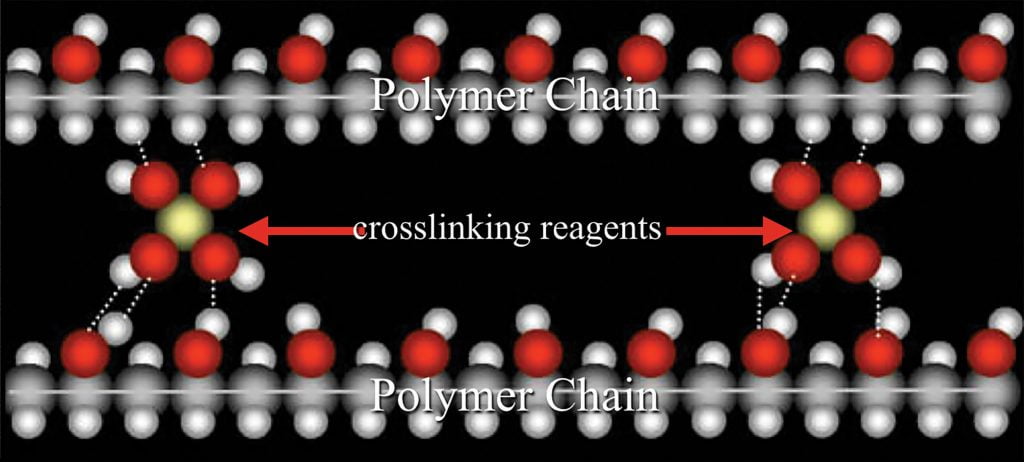

GuttaCore carriers

GuttaCore carriers have measurement rings identical to Thermafil but are available only up to size No. 90. They are made of a thermoset cross-linked gutta percha. A cross-link is an irreversible process that ties all the molecules of a polymer together with covalent bonds into a giant supermolecule (Figure 7) (Jenkins, et al., 1996). Cross-links can be formed by chemical reactions that are initiated by specific chemicals called cross-linking reagents. According to the number of cross-links, the physical property of the materials, like resistance to heat and flexibility, can change dramatically. The resulting material is called thermoset plastic material (Jenkins, et al., 1996; Alhashimi, et al., 2014).
GuttaCore obturator cores are made from a cross-linked, thermoset elastomer of gutta percha that cannot be melted and that increases the bond strength between the carrier itself and the external layer of gutta percha (Alhashimi, et al., 2014). Alhashimi, et al. (2014), demonstrated a significantly higher push-out bond strength of the gutta-percha coating in GuttaCore compared with Thermafil. Consequently, it is not possible to remove the external coating of gutta percha from the core and to utilize the GuttaCore carriers as a verifier.
Two types of GuttaCore are available in certain countries with gray (first generation) and pink (second generation) carriers (Figure 8). The composition of the two types of obturators is identical and includes polyisoprene and a tougher rubber called EPDM (ethylene propylene diene monomer). The cross-linking occurs via peroxide and a tri-functional cross-linking agent chosen to improve the physical properties. The remaining physical properties are developed through the addition of silica and fibers. Radiopacity is obtained by adding tungsten in gray GuttaCore and bismuth oxide in pink GuttaCore. The pink color is produced by the colorants. Clinically, the substitution of tungsten with bismuth oxide increases the resistance to pressure and flexibility of the pink carriers (Figures 9 and 10).
The GuttaCore carrier resists high temperature and can be heated in the ThermaPrep® Oven (Dentsply Sirona) without problems. The best way to sever the GuttaCore handle is to use a sharp spoon excavator at the canal orifice. This method allows precise cuts and leaves the pulp chamber floor relatively clean. It is also possible to bend the obturators to sever the handle as suggested by the manufacturers, but this technique does not work well in small access cavities, since it can leave a portion of the carrier protruding into the pulp chamber. It is also possible to use long neck, high-speed cutting burs, but they create a lot of debris. Thermacut Prep burs or System B tips do not properly sever the thermoset gutta- percha handle of the GuttaCore, so they are contraindicated.



Gutta percha
According to the manufacturers, the gutta percha used for the external coating in GuttaCore and Thermafil is exactly the same: alpha phase gutta percha. Indeed, chemically pure gutta percha exists in two distinct, different crystalline forms: alpha and beta. The α phase gutta percha shows an ordered molecular arrangement and is brittle and fragile at room temperature, but becomes adhesive and highly flowable when heated. Furthermore, it is unstable and slightly compressible (Schilder, Goodman, Aldrich, 1985). The β phase gutta percha shows a disordered molecular arrangement, is stable, flexible, and compressible at room temperature, but becomes less adhesive and flowable when heated. The α and β phases are interchangeable depending on the temperature of the material (Schilder, Goodman, Aldrich, 1985).
Whereas most commercially available forms are in the beta structure, newer products have adopted the alpha-crystalline structure for compatibility with the thermo-softening of the material during obturation. Indeed, produced in the alpha phase, the gutta percha undergoes less shrinkage during cooling and needs less compaction pressure to compensate for any shrinkage that may occur (Cantatore, Johnson, 2009). It has been advocated (Cantatore, et al., 2004; Cantatore, Lupoli, Menghini, 1993; Cantatore, 1995) that the α phase gutta percha used for Thermafil and GuttaCore undergoes physical treatments able to degrade the long polycarbonate chains freeing low molecular weight fragments that are responsible for the low viscosity of the polymer, as well as for its capacity to penetrate the dentinal tubules and the lateral canals.
Without a doubt, the gutta percha used for the carrier-based obturators show a high rate of filling of the lateral canals as demonstrated in an ex vivo study on 445 root canals filled with GT obturators (Ruiz Piñón, et al., 2004). Lateral ramifications were detected in 110 teeth with a total of 129 lateral canals and a frequency of lateral ramifications/tooth (39.83%) (Ruiz Piñón, et al., 2004) (Figures 10 and 11).
Thus, Thermafil and GuttaCore gutta percha can be defined as a modified α phase polymer with excellent flow and sealing ability depending mainly on its low viscosity and ability to penetrate lateral canals and dentinal tubules (Figure 12) (Cantatore, Johnson, 2009).
Thermafil verifiers

For the root canal obturation with Thermafil or similar, two types of verifiers can be used: firstly, a plastic verifier, i.e., the obturators stripped of the gutta percha are used to stimulate the clinical condition that will occur when the complete obturator is moved into the root canal. The correct plastic verifiers should bind 1 mm short of the working length, and the position should be confirmed with an X-ray. An obturator of the same size is then chosen with the rubber placed at the same length (-1 mm working length) and is used for the root canal filling. Keeping the plastic carrier at 1 mm from the working length will avoid the risk of having a rigid material at the apical foramen and reduce overfilling (Cantatore, Johnson, 2009) (Figure 15).
Secondly, the metal verifier can be used for both Thermafil or GuttaCore. They are hand nickel-titanium instruments available with the same tip diameter as the obturators. They have a taper of 5% and cutting blades (radial lands like the old ProFiles®). The metal verifiers are used to check the size of the canal and the available space for the carrier and the plasticized gutta percha. They should be inserted to the working length, and their position should be confirmed with an apex locator and X-ray. Normally, the size of the correct metal verifier should correspond to that of the last apical file. Since the metal verifiers have a cutting action, they may be used for small adjustments of the canal shape until they can reach the working length without excessive friction.

Finally, since they cut dentin and produce smear layer, their use should be followed with adequate root canal irrigation. After the selection of the metal verifier, a Thermafil or GuttaCore of the same size will be chosen with the rubber stop placed at the working length (-1 mm) for the same reasons explained before (Figure 10) (Cantatore, Johnson, 2009).
GuttaCore verifiers
For the GuttaCore obturators, only the metal verifier can be used as previously described.
Sealing ability of carrier based obturators with plastic carrier
The quality of the apical seal obtainable with plastic carrier obturation has been assessed in vitro using many research methods. From a review of the scientific literature (41 articles) published from 1991 to 2012 (Cantatore, Johnson, 2009) on the apical sealing ability of the most popular obturation techniques, it is clearly evident that the apical sealing capabilities of the carrier-based obturators did not differ significantly from that of System B and the vertical condensation of warm gutta-percha technique.
Compared with cold lateral condensation, Thermafil gave better results in 17 of 30 studies (Cantatore, Johnson, 2009). The two techniques did not differ significantly in 10 of 30 studies. Lateral condensation gave better results than Thermafil in three of 30 studies (Cantatore, Johnson, 2009). If we consider the in vivo clinical studies published in the past 10 years, using Thermafil and cold lateral condensation in the filling of root canals did not result in significant differences in the clinical treatment outcome (Chu, Lo, Cheung, 2005; Hale, et al., 2012; Demirci, Çalışkan, 2016) (Figure 13).
Sealing ability of GuttaCore obturators
Considering the recent introduction of the GuttaCore obturators, the literature is scarce on their sealing ability and success rate. Li, et al. (2014), examined the quality of obturation in oval-shaped canals obturated by GuttaCore by comparing the incidence of gaps and voids identified from similar canals obturated by cold lateral compaction or warm vertical compaction. Both micro-CT and SEM data indicated that canals obturated with GuttaCore had the lowest incidence of interfacial gaps and voids, although the results were not significantly different from canals obturated by warm vertical compaction.
In another study, Schafer, et al. (2016), compared GuttaCore and GUTTAFUSION obturation techniques with lateral condensation in terms of the percentage of gutta-percha-filled areas (PGFA), sealer-filled areas (PSFA), and voids in straight root canals prepared with different instruments. The study authors concluded that GuttaCore and GUTTAFUSION, in comparison with lateral condensation, produced more homogenous root canal fillings with higher PGFA and a low incidence of voids independent of the instrument used for canal preparation (Schafer, et al., 2016).
Finally, Thermafil and GuttaCore were compared in a recent study from Neuhaus, et al. (2016), who assessed filling characteristics (adaptation, homogeneity, sealer percentage, position of the carrier) of warm (Thermafil and GuttaCore) and cold obturation methods (single cone) in curved root canals. The proportion of sealer and of voids per area were significantly greater when roots were obturated with a single cone technique. No significant differences were reported between Thermafil and GuttaCore in curved root canals (Figure 14) (Neuhaus, Shick, Lussi, 2016).
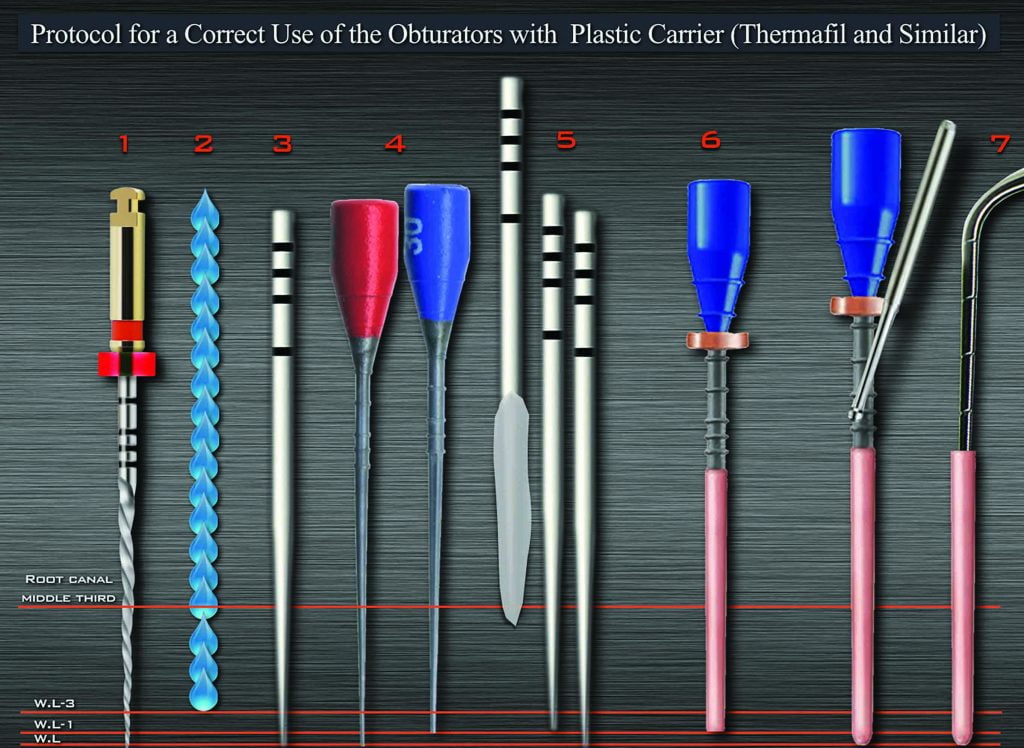

Protocols for use
The protocols of use are summarized in Figures 15 and 16.
Final considerations
- Thermafil and GuttaCore offer good three-dimensional obturation.
- Thermafil and GuttaCore require continuous tapered canals.
- Thermafil and GuttaCore gave the best results in long and curved canals.
- Thermafil and GuttaCore are not indicated in straight and short canals and teeth with open apices.
- Thermafil and GuttaCore can cause extrusion of the obturation materials (the risk is slightly higher for GuttaCore).
- The risk of extrusion can be minimized following a precise protocol (more on this in the second part of the article).
- Thermafil is the best choice in case of intracanal impediments.
- GuttaCore is the best choice in case of a post space preparation and in cases of retreatment (more in the second part in Endodontic Practice US).
To dispel some common myths about carrier-based obturators read Dr. Andrei Zoryan’s article, “GuttaCore® system: a step forward in the evolution of endodontics” here.
References
- Alhashimi RA, Foxton R, Romeed S, Deb S. An in vitro assessment of gutta-percha coating of new carrier-based root canal fillings. ScientificWorldJournal. 2014; 2014(239754):1-6.
- Cantatore G. The sealing capabilities of Thermafil gutta-percha. Dental Cadmos. 1995;11:38-47.
- Cantatore G, Goracci G, Maviglia P. Thermafil, un nuovo sistema per l’otturazione canalare. Dental Cadmos Dossier. 1992;15:13-48.
- Cantatore G, Goracci G, Maviglia P. Sistema Thermafil nelle otturazioni canalari: analisi sperimentale. Dental Cadmos. 1993;4:11-38.
- Cantatore G, Johnson WB. The Thermafil System. In Castellucci A: Endodontics Vol 2. Milano, Italy: Martina Ed; 2009.
- Cantatore G, Lupoli G, Menghini A. A SEM analysis of several dental gutta-perchas. Attualità dentale. 1993;26:8-28.
- Cantatore G, Varela Patiño P, Biedma BM, Ruiz Piñón M. Frequenza e localizzazione dei canali laterali dopo otturazione canalare con GT Obturators: uno studio radiografico in vitro. G It Endo. 2004;18(4):185-191.
- Chu CH, Lo EC, Cheung GS. Outcome of root canal treatment using Thermafil and cold lateral condensation filling techniques. Int Endod J. 2005;38(3):179-185.
- Demirci GK, Çalışkan MK. A prospective randomized comparative study of cold lateral condensation versus core/gutta-percha in teeth with periapical lesions. J Endod. 2016;42(2):206-210.
- Hale R, Gatti R, Glickman GN, Opperman LA. Comparative analysis of carrier-based obturation and lateral compaction: a retrospective clinical outcomes study. Int J Dent. 2012:954675.
- Jenkins AD, Kratochvíl P, Stepto RFT, Suter UW. Glossary of basic terms in polymer science (IUPAC Recommendations 1996). Pure and Applied Chemistry. 1996;6(12):2287–2311.
- Johnson W. A new gutta-percha technique. J Endod. 1978;4(6):184-88
- Li GH, Niu LN, Selem LC, et al. Quality of obturation achieved by an endodontic core-carrier system with crosslinked gutta-percha carrier in single-rooted canals. J Dent. 2014;42(9):1124-1134.
- Li GH, Niu LN, Selem LC, Eid AA, Bergeron BE, Chen JH, Pashley DH, Tay FR. characteristics of carrier-based techniques vs. single cone technique in curved root canals. Clin Oral Invest. 2016;20(7):1631-1637.
- Ruiz Piñón M, Cantatore G, Varela Patiño P, Biedma BM. Frequency and localization of lateral ramifications after root canal obturation with GT obturators [master’s thesis]. Compostela, Spain: University of Santiago; 2004.
- Schafer E, Schrenker C, Zupanc J, Burklein S. Percentage of gutta-percha filled areas in canals obturated with cross-linked gutta-percha core-carrier systems, single-cone and lateral compaction technique. J Endod. 2016;42(2):294-298.
- Schilder H, Goodman A, Aldrich W. The thermomechanical properties of gutta-percha. Part V. Volume changes in bulk gutta-percha as a function of temperature and its relationship to molecular phase transformation. Oral Surg Oral Med Oral Pathol. 1985;59(3):285-296.
Stay Relevant With Endodontic Practice US
Join our email list for CE courses and webinars, articles and more..


